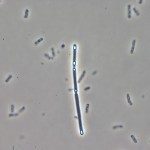Link to Pubmed [PMID] – 11902727
Mol. Microbiol. 1997 Jul;25(1):65-78
Glucose is the preferred carbon and energy source of Bacillus subtilis. It is transported into the cell by the glucose-specific phosphoenolpyruvate:sugar phosphotransferase system (PTS) encoded by the ptsGHI locus. We show here that these three genes (ptsG, ptsH, and ptsI) form an operon, the expression of which is inducible by glucose. In addition, ptsH and ptsl form a constitutive ptsHI operon. The promoter of the ptsGHI operon was mapped and expression from this promoter was found to be constitutive. Deletion mapping of the promoter region revealed the presence of a transcriptional terminator as a regulatory element between the promoter and coding region of the ptsG gene. Mutations within the ptsG gene were characterized and their consequences on the expression of ptsG studied. The results suggest that expression of the ptsGHI operon is subject to negative autoregulation by the glucose permease, which is the ptsG gene product. A regulatory gene located upstream of the ptsGHI operon, termed glcT, was also identified. The GlcT protein is a novel member of the BglG family of transcriptional antiterminators and is essential for the expression of the ptsGHI operon. A deletion of the terminator alleviates the need for GlcT. The activity of GlcT is negatively regulated by the glucose permease.

